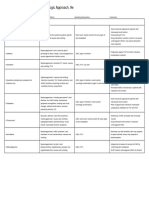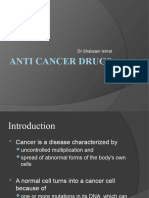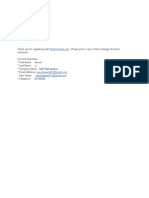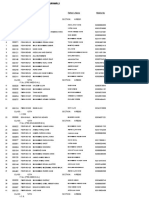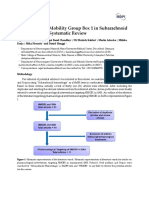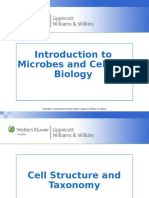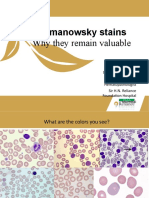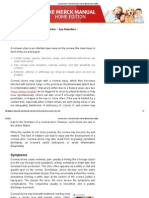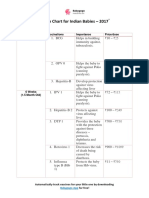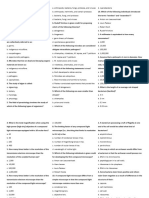The Immunosuppression 2021
Uploaded by
Muhammad AliThe Immunosuppression 2021
Uploaded by
Muhammad AliImmunosuppression and chemotherapy
Classification
By class/mechanism
Cytotoxics
Antimetabolites
Purine antagonists
Pyrimidine antagonists
Both
Topoisomerase inhibitors
Agents that bind DNA covalently
Alkylating agents
Platinum compounds
Spindle inhibitors
Vinca alkaloids
Taxanes
Non-cytotoxics
Corticosteroids
T-cell inhibitors
Hormonal agents
Immunomodulators
Interferons
Monoclonal antibodies (some are selectively cytotoxic)
Physical therapies
Plasmapheresis
Irradiation
By interaction with cell cycle
• Class I: non-specific for dividing/resting cells e.g. nitrogen mustard
• Class II: specific for certain phases of division e.g. MTX
• Class III: all phases of division e.g. nitrosoureas
Indications
• Neoplasia
o Often as part of combined modality therapy, which may also comprise radiotherapy and surgery
E.g. neoadjuvant/adjuvant use (to reduce bulk/to eradicate micrometastases)
Pulsed use to allow marrow recovery
o Aims vary
Eradication/cure
Remission induction
Symptom control
• Autoimmune disease
• Transplantation
o Differs from autoimmune disease in being predictable event, hence can prophylactically
immunosuppress and monitor for rejection, rather than treating an established response (more
difficult)
o Some regimes used
Induction/maintenance of immunosuppression
à Ciclosporin monotherapy
1/10
à Ciclosporin+prednisolone
à Ciclosporin+prednisolone+azathioprine
à Ciclosporin+prednisolone+azathioprine+poly-/monoclonal antibody
Treatment of acute rejection
à High-dose prednisolone
à Poly-/monoclonal antibody
Principles
How to choose
• Nature of process
o In neurology: which side of BBB – peripheral/central
o Type of process: ?T ?B cells
• Risks vs. benefits
Main indications in neurology
• Antibody-mediated disease (e.g. myasthenia, stiff person syndrome)
• Demyelinating disease (e.g. GBS, CIDP)
• Vasculitis
• Inflammatory muscle disease
Drug combinations
• Multiple agents used at doses close to maximum tolerated
• Use agents with different mechanisms of action/different SE profile
o More effective
o Less SEs
Dose usually adjusted for BSA
Resistance
• MDR1 (multidrug resistance gene) encodes ATP-dependent transporter that effluxes certain cytotoxics out
of cells; higher expression in tumours
Cytotoxics
Shared adverse effects
Cytotoxic agents cause death of rapidly dividing tumour cells. Selectivity is based upon the high mitotic rate of the
tumour. Death of normal body cells occurs related to the rate of their division, and pertains particularly to the most
rapidly dividing tissues:
• Hair alopecia
• GI epithelium mucositis, PU, diarrhoea
• Bone marrow suppression pancytopenia
Æ prone to infections (incl. opportunistic),
malignancy
• Fetus teratogenic/fetotoxic
Excessive rapid cell death causes hyperuricaemia – can be prevented with
• Xanthine oxidase inhibitor: allopurinol, febuxostat
• Adequate hydration
N&V is caused by stimulation of CTZ
• Acute
o 5HT3 antagonists can be particularly useful (in combination with dexamethasone) in patients at
high risk of emesis or unresponsive to other therapies
• Delayed
o Dexamethasone plus metoclopramide or prochlorperazine
• Anticipatory
o Good control of acute and delayed emesis
o Addition of lorazepam (amnesic, sedative and anxiolytic)
2/10
Extravasation of irritant drugs into extravascular tissues causes local tissue necrosis
Antimetabolites
Chemical analogues of normal cell metabolites that become incorporated into nuclear material or inhibit essential
enzymic steps in cellular metabolism
Purine antagonists
• Analogues: azathioprine, 6-MP
• Inosine monophosphate dehydrogenase inhibitor: mycophenylate
Pyrimidine antagonists
• Analogues: 5-FU, cytarabine (cytosine arabinoside)
• Dihydroorotate dehydrogenase inhibitor: leflunomide
Both
• Folate antagonist: MTX
• Ribonucleotide reductase inhibitor: hydroxyurea
Azathioprine
Mechanism
• Prodrug, metabolised to 6-mercaptopurine, a purine nucleotide analogue that competes with inosine
monophosphate in synthesis of AMP and GMP
• Blocks DNA/RNA synthesis, toxic to dividing lymphocytes
Adverse effects
• Affects all rapidly dividing cells as above
• Also hepatotoxic
o Toxic bone marrow suppression/hepatitis probably secondary to TPMT deficiency
o Opportunistic/bacterial infections possible, esp. if monitoring stopped
• PUO/flu-like symptoms
o Unrelated to TPMT
Thiopurines (azathioprine, 6-MP, thioguanine) are eliminated via
• Thiopurine methyltransferase (TMTP)
o Polymorphic: 90% high activity (risk of undertreatment), 10% intermediate activity, 0.3% low
activity (risk of toxicity)
o Check TMTP activity before starting drug.
Normal 2-4mg/kg/day
50-100% 1-2mg/kg/day + monitor
<50% use alternative
• Xanthine oxidase. Inhibitors predispose to toxicity though allopurinol is used to counter hyperuricaemia –
must at least halve dose of azathioprine.
Note
• Monitor FBC and LFT
• Widely used in organ transplantation and auto-immune disease
• Used at high dose when aiming to eliminate all dividing lymphocytes e.g. pre-marrow transplantation
Mycophenylate
Mechanism
• Active drug, and converted in body to more active metabolite mycophenolic acid
• Reversible inhibitor of inosine monophosphate dehydrogenase, a key enzymic step in purine nucleotide
biosynthesis
• Highly selective for T and B cells, as lymphocytes have no salvage pathway for purine synthesis
• More selective than azathioprine, and more effective in preventing acute rejection
Adverse effects
• Similar to those of azathioprine
o Side-effects related to inhibition of lymphocyte proliferation may be more severe (i.e. intercurrent
infection with organisms largely cleared by lymphocyte activity)
3/10
o Effect on other dividing tissues may be less severe
• GI side-effects are prominent
Note
• Monitor FBC and LFT
• Currently licensed for prophylaxis of acute renal transplant rejection only
Methotrexate
• Inhibits
o DHFR, required for purine, pyrimidine and protein (methionine and serine ααs) synthesis
o 5-amino-imidazole-4-carboxyamide-ribonucleotide (AICAR) transformylase
• Folinic acid helps prevent methotrexate-induced myelosuppression/mucositis – can now give myelotoxic
doses and then ‘rescue’ the marrow with folinic acid after e.g. 24h
Adverse effects
• Mucositis
• Hypersensitivity pneumonitis (5%)
• Hepatitis
• Teratogenic
Interactions
• Çlevels by NSAIDs (displace MTX from protein), penicillin, probenecid
Note
• Check baseline CXR and lung function tests
• Start at 7.5mg PO weekly, increase in steps of 2.5mg to maximum of 25mg
• Monitor FBC and LFT
• Ensure patient receives NPSA information leaflet – fertility can be impaired
Hydroxyurea (hydroxycarbamide)
Urea analogue, inhibits ribonucleotide reductase.
Adverse effects
• Leg ulcers – may not heal unless drug stopped
• N, V, D
• Bone marrow suppression
• Rashes
Topoisomerase inhibitors
E.g. doxorubicin, daunorubicin, etoposide
Mechanism
• Stabilise cleavable complex formed by topo 2 + DNA Æ double strand break
• Anthracyclines also possess hydroxyquinone moiety that generates free radicals; not necessary for
antitumour effect, but explains increased cardiotoxicity
Adverse effects
GI side-effects are a particular problem
Alkylating agents
Mechanism
Form reactive ion that alkylates N7 of guanine (most nucleophilic part of DNA)
DNA strands then either break or cross-link
Groups
Nitrogen mustards: cyclophosphamide, melphalan, chlorambucil bifunctional
Aziridines: mitomycin bifunctional
4/10
Nitrosoureas: lomustin, carmustin bifunctional
Alkylsulphonates: busulphan bifunctional
Methylating agents: procarbazine ?also mild MAO-I/disulfiram actions
Adverse effects (esp. relevant for cyclophosphamide and chlorambucil)
• Dose-dependent lymphopenia, B>T cells, CD8>>CD4 cells
• Gametogenesis is severely affected
o All males and most females become infertile
o Consider sperm banking or ovarian preservation
• Haemorrhagic cystitis is a common manifestation of urothelial toxicity of cyclophosphamide, due to a
metabolite. This can be prevented by the use of Mesna which specifically reacts with the metabolite in the
urinary tract and inactivates it.
• Bladder tumours (10x baseline risk). Monitor for haematuria and proceed to cytoscopy if develops.
• NHL (11x baseline risk)
• Opportunistic infections
o Need PCP prophylaxis (1st line co-trimoxazole, 2nd line azithromycin, 3rd line atovaquone)
o Watch for TB, VZV, PML
• Monitor FBC weekly, discontinue if lymphocytes<0.4·109 or neutrophils<1-1.5·109
Note
• Particularly used to treat haematological malignancies
• Cyclophosphamide dosing
o PO 2-4mg/kg/day
o IV pulse 10mg/kg/day or 0.75-1g/m2, variable pulse intervals, faster onset
• Carmustin implants (Gliadel® wafer) used in GBM debulking
Platinum compounds
E.g. cisplatin, carboplatin
Mechanism
Interacts with purine and pyrimidine bases in DNA to cause inter- and intra-strand cross-links
Adverse effects
• Neuro-, nephro- and ototoxicity are a problem
• Very emetic – needs 5-HT3 antagonist cover
Note
Useful for ovarian, lung and testicular tumours
Vinca alkaloids
E.g. vincristine, vinblastine
Mechanism
Bind to tubulin and inhibit its polymerisation
Note
Also inhibit other activities linked to microtubules:
• Phagocytosis
• Axonal transport (Æ peripheral neuropathy – sensory>autonomic>>motor)
Taxanes
Paclitaxel (Taxol®) – from bark of yew
Docetaxel (Taxotere®) – synthetic
Mechanism
Stabilise microtubules Æ mitotic spindle cannot contract during mitosis
5/10
Adverse reactions
Severe hypersensitivity reactions are common and routine prophylactic therapy to prevent reactions should be
employed
Note
• Considered by oncologists to be a major advance in solid tumour chemotherapy
• Licensed/embraced by NICE for treatment of advanced solid tumours, e.g. ovarian cancer (paclitaxel),
NSCLC (paclitaxel), and breast cancer (docetaxel, paclitaxel – if anthracycline failed/inappropriate)
Corticosteroids
Mechanism
• All pharmacological derivatives of glucocorticoids
o Bind to ubiquitous intracellular receptors, steroid-receptor complex enters nucleus and regulates
transcription of specific genes (up to 1% of all genes)
o Exaggerated glucocorticoid response due to supra-physiological concentrations of ligand
• Prednisolone is most commonly used
o Four times more potent anti-inflammatory action than cortisol
Physiological effects
Suppression of
• Phagocyte function
• Lymphocyte recirculation
• T-cell activation
• Cytokine release
Lymphocytotoxic for >20mg prednisolone/day
Increased endonuclease activity and induction of apoptosis of lymphocytes and eosinophils
Adverse effects
• ÇWCC
o Due to Èmargination/emigration
o Lasts 7-10 days
• Cushing’s!
o Hence often combined with other (‘steroid-sparing’) agents to minimise dose necessary
o Start bone protection immediately – majority of bone loss occurs in first 3m
o Monitor glu/BP
• Growth retardation if young
• Potentially teratogenic (fetal growth retardation, ?cleft palate)
• Not present in breast milk at low (<40mg/day) dose
• Risk of opportunistic infections >20mg prednisolone/day (e.g. PCP, fungal, viral)
• Anaphylaxis (IVMP pulses – give dilute and slowly)
Interactions
• Çmetabolism by hepatic enzyme inducers
Drugs interfering with T-cell signalling
Ciclosporin = fungal peptide product
Tacrolimus (FK506) and sirolimus (rapamycin) = macrolides made by soil-dwelling bacteria
Big advance esp. in organ transplantation (now >80% 1-year survival for kidneys)
Ciclosporin has for many years been the leading compound in immunosuppression in organ transplantation; its
position is now being challenged by the macrolide-based agents.
Mechanism
Block the expression of several cytokine gene products required for T-cell activation
6/10
Ciclosporin and tacrolimus
• Calcineurin blockers
• Bind to immunophilins (family of intracellular proteins) – complex prevents calcineurin-dependent
dephosphorylation of NFAT-P (nuclear factor of activated T-cells), which is produced in response to
antigen binding. Thus no stimulation of antigen receptor response element in IL-2 promoter.
Sirolimus
• Non-calcineurin blocking immunosuppressant
• Binds to MTOR (mammalian target of rapamycin)
• Can be combined with ciclosporin or tacrolimus
Adverse effects
• Dose-dependent nephrotoxicity
o Narrow therapeutic window/variable pharmacokinetics Æ monitor levels
o HT, oedema, K+ retention (?hyporeninaemic hypoaldosteronism)
o ARF (vasoconstriction), CRF (fibrosis)
• Hyperlipidaemia
• Hepatotoxicity
• Gum hyperplasia
• Hirsutism; not alopecia
• Burning hands and feet (esp. 1st week)
• Tremor
• DM
• Skin/lymphoproliferative malignancy
• Oligodystrophy
• Opportunistic infections, esp. viral (warts, EBV lymphoma)
Tacrolimus is more nephrotoxic and also neurotoxic
Interactions
Çby hepatic enzyme inhibitors, non-DHP CCBs, OCP
Èby hepatic enzyme inducers
Note
• Monitor trough levels
o Ciclosporin – aim for 100-200ng/ml
o Tacrolimus – aim for 5-10ng/ml
Monoclonal antibodies
There is currently great interest in monoclonal antibody therapy in transplantation and immune disease.
Nomenclature
1. Prefix
− Distinct syllable to make unique
2. Disease/target
− Viral vir-
− Bacterial bac-
− Immune lim-
− Infectious les-
− Cardiovascular cir-
− Carcinoma
- Colon col-
- Melanoma mel-
- Mammary mar-
- Testis got-
- Ovary gov-
- Prostate pr(o)-
- Miscellaneous tum-
3. Animal source
− Human u
7/10
− Mouse o
− Rat a
− Hamster e
− Primate i
− Chimaeric xi [drop consonant for class]
− Humanised zu
4. Suffix
− Monoclonal antibodies and fragments -mab
− Toxin -tox
− Fusion protein -cept
Examples
Infliximab/adalimumab/etanercept
• Prevent TNFα action
o Infliximab = chimeric antibody – mouse Fab, human Fc
o Adalimumab = fully human antibody
o Etanercept = P75 binding domain genetically engineered to IgG Fc
• Licensed for treatment of
o RA
NICE recommends either infliximab or etanercept for highly active RA which has failed
to respond to at least 2 standard DMDs, incl. methotrexate (unless methotrexate is
contraindicated or not tolerated)
Withdraw if no response by 3m
No evidence to support treatment beyond 4y (but the agents are still very new) – make an
individual decision
o Infliximab: IBD (severe active Crohn's refractory to steroids/other immunosuppressants, refractory
fistulas), AnkSpond
o Etanercept: AnkSpond, juvenile idiopathic arthritis
• Absolute and relative contraindications: STOIC (sepsis, TB, optic neuritis/demyelination, infusion reaction,
cancer)
• Main adverse effects
o Infections (esp. TB Æ get baseline CXR)
o Malignancy: esp. lymphoma; risk yet poorly defined, as drugs are quite new
o Blood dyscrasias
o SLE-like syndrome (infliximab>>etanercept), autoantibody formation
o Hypersensitivity
o Demyelination: central (MS, optic neuritis) and peripheral
o Development of inhibitory antibodies – combine with MTX
Anakinra
• Inhibits IL1
• Licensed for treatment of
o RA, in combination with methotrexate, if RA has not responded to methotrexate alone; NICE does
not recommend it unless used in a controlled long-term clinical study
• Role in myeloma?
Rituximab (MabThera®)
• Anti-CD20
• Causes complement-mediated B-cell lysis
• Marked ÈIg and ÈB cells – check lymphocyte subsets after Rx
• Licensed for treatment of (NICE guidance)
o NHL
Follicular lymphoma
à First treatment if stage III/IV
à Maintenance treatment in relapse/refractory disease responding to induction
therapy
à Treatment in chemoresistance, or in second or later relapse
CD20-positive diffuse large B-cell NHL (hence CHOP Æ rCHOP)
o RhA: in combination with methotrexate, in severe disease, in patients with inadequate
response/intolerance to DMDs incl. at least one anti-TNF therapy
• Can cause severe cytokine release (“capillary leak syndrome”) – give under
analgesic+antihistamine+steroid cover
• High risk of opportunistic/bacterial infections – incl. PML
8/10
Imatinib (Glivec®)
• Blocks tyrosine kinase that is overexpressed in CML
Trastuzumab (Herceptin®)
• Licensed for treatment of metastatic breast cancers overexpressing HER2 (human epidermal growth factor
receptor 2)
o In combination with paclitaxel (a taxane), in patients who have not received chemotherapy and in
whom anthracycline treatment is inappropriate
o As monotherapy, in patients who have received at least 2 chemotherapy regimes
Basiliximab
• Chimeric antibody, prevents IL2 action
• Licensed for prophylaxis of acute rejection in allogenic renal transplants
Alemtuzumab (Campath®)
• Anti-CD52 antibodies for the treatment of Wegener’s granulomatosis; hence particular interest in
Cambridge
• Similar to Rituximab but less specific for B cells, also kills T cell Æ greater immunosuppression
• SEs similar
Immunomodulators
Interferon alfa
Lymphotoxic
Possible indications
• Hairy cell leukaemia
• Chronic hepatitis B and C
Pegylated varieties persist have a longer duration of action.
Interferon beta
Possible indications
• Relapsing, remitting MS (at least two attacks of neurological dysfunction over previous 2-3 years, followed
by complete or incomplete recovery) in patients who are able to walk unaided
o Recent study shows that may be effective in first episode if clinically and radiologically very
suggestive
• IFN beta-1b is also licensed in secondary progressive MS
• Neither of the above is currently recommended by NICE
Physical therapies
Plasmapheresis
• Removal of serum Ig by extracorporeal circuit
• Rapidly removes pathogenic antibody
• Must be combined with B lymphotoxic drug to prevent rebound (e.g. cyclophosphamide, steroids)
• Combination with IVIg very powerful
• Risks include cardiovascular instability
IVIg
• Mode of action unclear – putative mechanisms
o Inhibits cytokine production, T-cell activation, antibody production
o Fc blockade
o Complexing of cytokines
• Exclude IgA deficiency
o Send baseline even if unable to check before starting
o Even IgA depleted preparations contain some IgA
• Risks include
o Hyperviscosity with ultra-rapid infusion 2g/kg/day, esp. in arteriopathy
9/10
o Renal failure, esp. if pre-existing renal disease (sugar load), rheumatoid factor, cryoglobulins
Daily UE – stop if Çcrea by >10%
o Aseptic meningitis
o Transmission of infection
Written consent, record batch no, check pre-IVIg LFTs and HCV status
10/10
You might also like
- Primary Chemotherapy: Adjuvant Chemotherapy: Neoadjuvant Chemotherapy: Treatment RegimensNo ratings yetPrimary Chemotherapy: Adjuvant Chemotherapy: Neoadjuvant Chemotherapy: Treatment Regimens7 pages
- Anticancer Drugs: Dr. R. Jamuna Rani MD, Professor & Hod Dept. of PharmacologyNo ratings yetAnticancer Drugs: Dr. R. Jamuna Rani MD, Professor & Hod Dept. of Pharmacology69 pages
- Anticancer Drugs: Pharm 3620 Human Pharmacology and Therapeutic PrinciplesNo ratings yetAnticancer Drugs: Pharm 3620 Human Pharmacology and Therapeutic Principles34 pages
- Antineoplastic Agents: Samuel A. Camorongan, RNNo ratings yetAntineoplastic Agents: Samuel A. Camorongan, RN45 pages
- Anticancer Drugs: Pharm 3620 Human Pharmacology and Therapeutic PrinciplesNo ratings yetAnticancer Drugs: Pharm 3620 Human Pharmacology and Therapeutic Principles29 pages
- Table 104 8 Monitoring of Anticancer Drugs SP em ActivityNo ratings yetTable 104 8 Monitoring of Anticancer Drugs SP em Activity13 pages
- Chemotherapeutic Agents and AntiinfectivesNo ratings yetChemotherapeutic Agents and Antiinfectives64 pages
- 2 1 Chemistry and Pharmacology of Anticancer Drugs - Docx-8-13No ratings yet2 1 Chemistry and Pharmacology of Anticancer Drugs - Docx-8-136 pages
- Drug Summary Table: Chapter 37 Pharmacology of Cancer: Genome Synthesis, Stability, and MaintenanceNo ratings yetDrug Summary Table: Chapter 37 Pharmacology of Cancer: Genome Synthesis, Stability, and Maintenance6 pages
- Cancer Drugs Drugs Indication Adverse Effects Interaction and ContraindicationNo ratings yetCancer Drugs Drugs Indication Adverse Effects Interaction and Contraindication5 pages
- Thioguanine and Mercaptopurine Pharmaco-OncologyNo ratings yetThioguanine and Mercaptopurine Pharmaco-Oncology23 pages
- Conventional Anticancer Chemotherapy Part 1No ratings yetConventional Anticancer Chemotherapy Part 157 pages
- Top 100 Drugs Pocket Reference Guide (2023 Edition)From EverandTop 100 Drugs Pocket Reference Guide (2023 Edition)No ratings yet
- Critical Care Medications: Anti-Arrhythmics Study Guide: Critical Care EssentialsFrom EverandCritical Care Medications: Anti-Arrhythmics Study Guide: Critical Care EssentialsNo ratings yet
- Indus Hospital - Serving The Humanity - Current VacanciesNo ratings yetIndus Hospital - Serving The Humanity - Current Vacancies7 pages
- Linkedin-Skill-Assessments-Quizzes - Microsoft-Word-Quiz - MD at Master Ebazhanov - Linkedin-Skill-Assessments-Quizzes GitHubNo ratings yetLinkedin-Skill-Assessments-Quizzes - Microsoft-Word-Quiz - MD at Master Ebazhanov - Linkedin-Skill-Assessments-Quizzes GitHub21 pages
- Maternal and Child Health MCQ Quiz Questions and Answers - ProProfs Quiz100% (3)Maternal and Child Health MCQ Quiz Questions and Answers - ProProfs Quiz5 pages
- Preclinical Characterization of ASP2713, A Novel INo ratings yetPreclinical Characterization of ASP2713, A Novel I9 pages
- Katalog Journals and Book Series 2023 DigitalNo ratings yetKatalog Journals and Book Series 2023 Digital165 pages
- Surah Ar-Rahman - Arabic Text With Urdu and English TranslationNo ratings yetSurah Ar-Rahman - Arabic Text With Urdu and English Translation13 pages
- Platelet Rich Plasma (PRP) Matrix Grafts: by David Crane, MD and Peter A.M. Everts, PHDNo ratings yetPlatelet Rich Plasma (PRP) Matrix Grafts: by David Crane, MD and Peter A.M. Everts, PHD73 pages
- Corneal Ulcer: Merck Manual Patients & Caregivers Eye DisordersNo ratings yetCorneal Ulcer: Merck Manual Patients & Caregivers Eye Disorders3 pages
- (eBook PDF) Microbiology: An Evolving Science 3rd Edition pdf download100% (2)(eBook PDF) Microbiology: An Evolving Science 3rd Edition pdf download53 pages
- Vaccination Chart For Indian Babies With Prices PDFNo ratings yetVaccination Chart For Indian Babies With Prices PDF6 pages
- Harnessing B Cell Responses For Personalized Approaches in HIV ManagementNo ratings yetHarnessing B Cell Responses For Personalized Approaches in HIV Management15 pages
- Transfusion Related Acute Lung Injury (Trali) : Presented by Intern DR Khagendra AcharyaNo ratings yetTransfusion Related Acute Lung Injury (Trali) : Presented by Intern DR Khagendra Acharya24 pages
- Full Oncogenic Viruses Volume 1: Fundamentals of Oncoviruses Moulay Mustapha Ennaji Ebook All ChaptersNo ratings yetFull Oncogenic Viruses Volume 1: Fundamentals of Oncoviruses Moulay Mustapha Ennaji Ebook All Chapters49 pages
- Review_Handbook_in_Diagnostic_Bacteriology_3rd_ed_Maria_Teresa_T (Copy 2).pdf (1)No ratings yetReview_Handbook_in_Diagnostic_Bacteriology_3rd_ed_Maria_Teresa_T (Copy 2).pdf (1)465 pages
- Extraction of Bromelain From Pineapple Peels: S. Ketnawa, P. Chaiwut and S. RawdkuenNo ratings yetExtraction of Bromelain From Pineapple Peels: S. Ketnawa, P. Chaiwut and S. Rawdkuen8 pages
- Lab Policies Beta HCG - Cobas E601 Lab 4005No ratings yetLab Policies Beta HCG - Cobas E601 Lab 40055 pages























